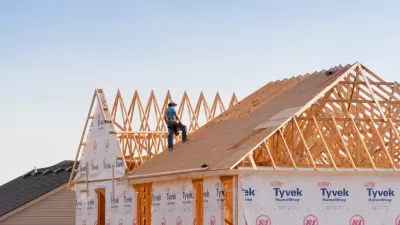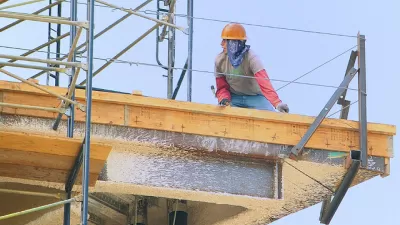The construction industry is licking its chops as plans for Sandy’s recovery take shape. After years of idleness due to the housing bust, builders and contractors find themselves ready to roll up their sleeves, and in need of a new workforce.
"I always look forward to a natural disaster," said Doug Palmieri, owner of Palmieri Construction in Middlefield, Conn. "The last two storms we had around here, the snow we had included, helped out the contracting business quite a bit."
Mr. Palmieri's assessment may sound crass, but for those in the construction industry, the damage incurred by Hurricane Sandy is a much-welcomed business opportunity. Construction companies along the East Coast are already inundated with calls, but are also concerned "about finding enough workers quickly," report Catherine Rampell and Shaila Dewan.
"Over the course of the recession, 60 to 75 percent of construction workers left the area because there was no work to keep them busy," said Pat Broom, owner of Phoenix Restoration, a 15-year-old company in Kill Devil Hills, N.C., on the Outer Banks.
Various factors, however, will slow reconstruction efforts. These include waiting for areas to dry out, for insurance companies to come through, and for out-of-state owners to be able to take action to restore their properties.
As the industry prepares for long-term recovery, experts consider the economic implications. Peter Morici, an economics professor a the Smith School of Business at the University of Maryland estimates, "that the economic losses from Sandy would be $35 billion to $45 billion, but that economic benefits from reconstruction and its ripple effects would total about $27 billion to $36 billion, not including gains of about $10 billion ‘from a more modern and productive capital stock.'"
FULL STORY: For Builders, the Storm Is Good for Business

Alabama: Trump Terminates Settlements for Black Communities Harmed By Raw Sewage
Trump deemed the landmark civil rights agreement “illegal DEI and environmental justice policy.”

Study: Maui’s Plan to Convert Vacation Rentals to Long-Term Housing Could Cause Nearly $1 Billion Economic Loss
The plan would reduce visitor accommodation by 25% resulting in 1,900 jobs lost.

Why Should We Subsidize Public Transportation?
Many public transit agencies face financial stress due to rising costs, declining fare revenue, and declining subsidies. Transit advocates must provide a strong business case for increasing public transit funding.

Paris Bike Boom Leads to Steep Drop in Air Pollution
The French city’s air quality has improved dramatically in the past 20 years, coinciding with a growth in cycling.

Why Housing Costs More to Build in California Than in Texas
Hard costs like labor and materials combined with ‘soft’ costs such as permitting make building in the San Francisco Bay Area almost three times as costly as in Texas cities.

San Diego County Sees a Rise in Urban Coyotes
San Diego County experiences a rise in urban coyotes, as sightings become prevalent throughout its urban neighbourhoods and surrounding areas.
Urban Design for Planners 1: Software Tools
This six-course series explores essential urban design concepts using open source software and equips planners with the tools they need to participate fully in the urban design process.
Planning for Universal Design
Learn the tools for implementing Universal Design in planning regulations.
Smith Gee Studio
Alamo Area Metropolitan Planning Organization
City of Santa Clarita
Institute for Housing and Urban Development Studies (IHS)
City of Grandview
Harvard GSD Executive Education
Toledo-Lucas County Plan Commissions
Salt Lake City
NYU Wagner Graduate School of Public Service





























